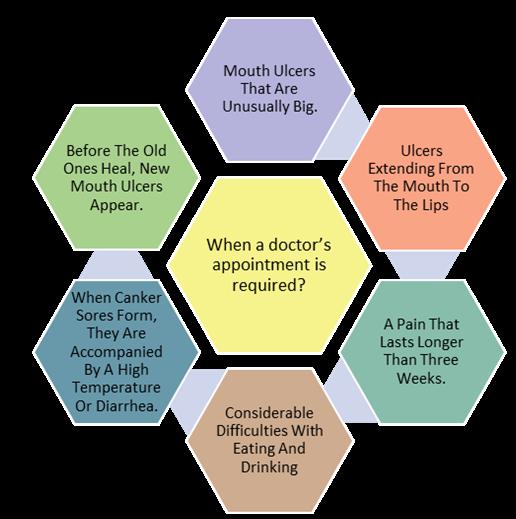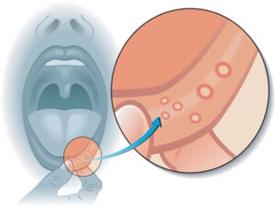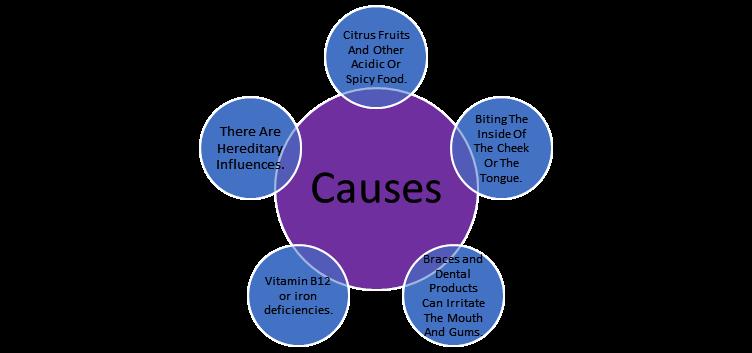
7 minute read
FCanker sores: Types and management
Dr. Rabiatul Basria S. M. N. Mydin1*, Alif Haikal Bin Elias1,2 and Anis Farhan Kamaruddin3
1 Oncological and Radiological Sciences Cluster, Advanced Medical and Dental Institute, Universiti Sains Malaysia, 13200 Kepala Batas, Pulau Pinang, Malaysia.
Advertisement
2 Department of Science Biology, Faculty of applied science, Universiti Technologi of MARA, Kampus Arau, 02600 Arau, Perlis, Malaysia.
3 Craniofacial & Biomaterial Sciences Cluster, Advanced Medical & Dental Institute, Universiti Sains Malaysia, 13200 Kepala Batas, Penang, Malaysia
* Corresponding Author: Dr Rabiatul Basria S. M. N. Mydin (PhD); Email: rabiatulbasria@usm.my; Tel: +604-5622351 only a week or two. However, they can indicate oral cancer or virus infection in some situations, such as herpes simplex (Lewis & Wilson, 2021).
Are canker sores cancerous?
Canker sores have distinct symptoms. New or persistent ulcers, on the other hand, must be examined. Canker sores are frequently painful, but mouth cancer is not. Canker sores heal in approximately two weeks, whereas mouth cancer does not heal and frequently spreads. Mouth cancer patches can be harsh, hard, and difficult to remove (Aphthous Mouth Ulcers, 2020). Mouth cancer is frequently characterized by a mix of red and white regions or huge white areas on the tongue, back of the mouth, gums, or cheeks. Mouth cancer is usually linked to alcohol consumption or cigarette usage (Mittal and Nautiyal, 2019). Mouth ulcers can affect anyone. However, if the condition worsens, professional healthcare should be contacted.
Canker sores
Canker sores, also known as aphthous ulcers, are tiny, painful lesions that form in the mouth or at the base of the gums. They can make eating, drinking, and conversing difficult. Women, adolescents, and persons with a family history of canker sores are more likely to develop them. Ulcers in the mouth are not contagious and usually heal in one to two weeks (Aphthous Mouth Ulcers, 2020). However, a dentist should be consulted if a canker sore becomes large or painful or does not cure after a long time (Mittal and Nautiyal, 2019).
Figure 1. Canker sores appear as small, painful swellings on the lips or inside the mouth (Hill, 2021). As depicted in Figure 1, these sores can occur on the lips, tongue, cheeks, gums, floor, and roof of the mouth, among other soft tissues.
The canker sore is a common illness that many people experience at some point in their lives. The canker sores can even develop on the oesophagus and the tube leading to the stomach (Aphthous Mouth Ulcers, 2020). Canker sores, for example, are usually a minor nuisance that lasts
Figure 2. Situation when a doctor’s appointment is required. An appointment with a dentist is needed when a condition such as Canker sores are massive, an ulcer that extends from the mouth to the lips, and pain that lasts longer than three weeks. These situations are usually not common when typical or minor canker sores occur. High body temperature because of the canker sores and a new ulcer that forms before the old one heals also needs to be checked out by the dentist.

Types of canker sores
There are three types of canker sores: minor, major, and herpetiform.
1) Minor
Minor canker sores are tiny, oval or circular ulcers that heal without scarring. This type is the most prevalent. This type might be as small as 2 millimetres (mm) or as large as 8 mm wide. These ulcers typically take up to two weeks to heal and cause minimal pain. They are tiny ulcers with a diameter of less than 5 mm that can occur singularly or in clusters. They usually do not cause discomfort and pain (Mittal and Nautiyal, 2019).
2) Major
Major ulcers are larger than minor ulcers, have an uneven shape, may be elevated, and penetrate deeper into the tissue than minor ulcers. As a result, they can take many weeks to clear and will most likely leave long-term scar tissue when they do. In addition, they might take up to six weeks to heal. These are rarer, measuring 5 mm or more, and can appear singly or in pairs (Aphthous Mouth Ulcers, 2020). They can be excruciatingly painful, especially when eating or drinking and can last from two weeks to several months (Lewis & Wilson, 2021).
3) Herpetiform
Adults are frequently affected with herpetiform canker sores, pinpoint in size and appear in clusters of 10 to 100. This form of canker sores has uneven edges and heals in one to two weeks without scarring. However, when many tiny lesions fuse to form massive, irregularly shaped ulcers, this can happen (Mittal and Nautiyal, 2019). Herpetiform ulcers are named from their appearance, similar to those of herpes. However, herpetiform ulcers are not caused by the herpes simplex virus (Lewis & Wilson, 2021).
Possible causes of canker sores

The specific cause of canker sores is unknown, and it differs from one person to the next. Ulcers can occur due to a particular medical disease or a dietary deficiency in some persons. In addition, ulcers can be caused by various factors, including celiac or Crohn’s disease, vitamin B12 or iron deficiencies (Aphthous Mouth Ulcers, 2020). Figure 3 shows a few principal reasons and conditions that aggravate canker sores.
infection might cause. Infections can be caused by an overpopulation of naturally occurring organisms in the mouth or by newly introduced species, such as the bacteria that cause gonorrhoea or syphilis. In addition, bacterial infections of the teeth or gums can create a pus-filled pocket of infection (abscess) or widespread inflammation (cellulitis) (Hennessy, 2021).
During the early stages of infection, syphilis may cause a red, painless sore (also known as a chancre) to appear on the lips or inside the mouth. The ache heals typically in a few weeks. However, if the syphilis is not treated, a white spot (mucous patch) may grow on the lip or inside the mouth 4 to 10 weeks later. The chancre and the mucous patch are highly infectious (Hennessy, 2021).
Candida albicans is a natural mouth flora. However, it can also overgrow in persons who have taken antibiotics or corticosteroids or who have a weakened immune system, such as AIDS patients. Candida can develop whitish, cheese-like patches that, when wiped away, erode the top layer of the mouth lining (thrush). At times, flat, red patches show (Hennessy, 2021). Klebsiella pneumoniae, Acinetobacter baumanii, Staphylococcus aureus, and Pseudomonas aeruginosa are the primary cause of canker sores (Anitha et al., 2016).
Management and treatment of canker sores
Pain and suffering from canker sores usually lessen in a few days and eventually disappear in about two weeks, with no need for therapy or medicine. However, a dentist may prescribe a treatment to minimize swelling and pain in those with more painful or frequent recurrences of canker sores. A dentist may also recommend an antimicrobial mouthwash or ointment that should be put directly to the wounded area. This treatment may assist in reducing discomfort. In addition, there are a variety of canker sores treatments accessible for online purchase (Lewis & Wilson, 2021).
Figure 3. Causes of canker sores. Canker sores can occur because of biting the inside of the cheek or the tongue, dental products that can irritate the mouth and gums, and hereditary influences can cause canker sores, as shown in figure 3. Besides that, citrus and other spicy food can cause mouth ulcers as they cause high acidity and are more likely to distress the skin.
Microbe’s related to canker sores
There are sores and swelling in the mouth that a bacterial
Doctors prescribe antibiotics to persons who have bacterial infections. It is essential to avoid any chemicals or drugs that produce canker sores. Frequently, gentle tooth brushing with a soft brush and salt-water rinses may aid in the prevention of sores becoming infected (Hennessy, 2021). Pharmacists should prescribe an antiseptic or a topical anti-inflammatory spray. If the person appears to be in excellent condition, symptomatic treatments with a warm saline mouthwash, topical chlorhexidine, or benzydamine spray may help (Hill, 2021). Patients are encouraged to see a dentist to remove any dental sources of trauma (Aphthous Mouth Ulcers, 2020). Aluminum-magnesium antacids and sucralfate-based protective coatings might be soothing when used as a rinse. However, many doctors include other chemicals like lidocaine and/or diphenhydramine (an antihistamine). Another option is amlexanox paste. Mouth rinses containing alcohol (ethanol) should be avoided because they may aggravate canker sores (Hill, 2021). After therapy, the oral epithelium should recover in a few days. If the ulcer lasts longer than three weeks, people should see their dentist to rule out the possibility of cancer (Lewis & Wilson, 2021).
Conclusion
Canker sores are rarely a cause for concern. They are relatively prevalent, with a variety of causes and triggers. Individuals who recognize their triggers may find it easier to avoid ulcer formation. There are many possible causes of canker sores that can be a concern and avoided. Microbes related to canker sores can cause severe or minor ulcers. Therefore, early diagnosis and treatment should be the precedence. Home remedies can help alleviate symptoms and hasten the healing process. The treatment and management of canker sores are relatively easy as they can be treated with a medication bought at the pharmacy. Anyone experiencing persistent sores that do not heal or sores that reoccur regularly should consult a doctor for a diagnosis and treatment.
Acknowledgement
The authors would like to thank Universiti Sains Malaysia for sponsoring this work under the research university grant RUI EKSESAIS 2019 (No:1001/CIPPT8012338).
References
1. Anitha, M., Monisha, D., Ramya, K., Chinmayee, Y., & Mohamed Sulthan, A. (2016). A study on the occurrence of bacterial isolation in mouth ulcer patients. International Journal Of Advanced Research In Biological Sciences (IJARBS), 3(10), 188-192. doi: 10.22192/ ijarbs.2016.03.10.025
2. Ada’s Medical Knowledge Team. (2020, February 14). Aphthous Mouth Ulcers. Ada. Retrieved November 22, 2021, from https://ada.com/conditions/aphthous-ulcers/.
3. Hennessy, B. (2021). Mouth Sores and Inflammation - Mouth and Dental Disorders - MSD Manual Consumer Version. Retrieved 30 November 2021, from https://www.msdmanuals.com/home/mouth-and-dentaldisorders/symptoms-of-oral-and-dental-disorders/mouthsores-and-inflammation
4. Hill, A. (2021). Canker Sores (Causes & How to Get Rid of Them Quickly). Retrieved 30 November 2021, from https://www.newmouth.com/oral-health/canker-sores/
5. Lewis M. & Wilson N. (2021, April 22). Oral ulceration: Causes and management. The Pharmaceutical Journal. Retrieved November 25, 2021, from https:// pharmaceutical-journal.com/article/ld/oral-ulcerationcauses-and-management.
6. Mittal, S., & Nautiyal, U. (2019). A review: herbal remedies used for the treatment of mouth ulcer. International Journal of Health and Clinical Research, 2(1), 17-23.



